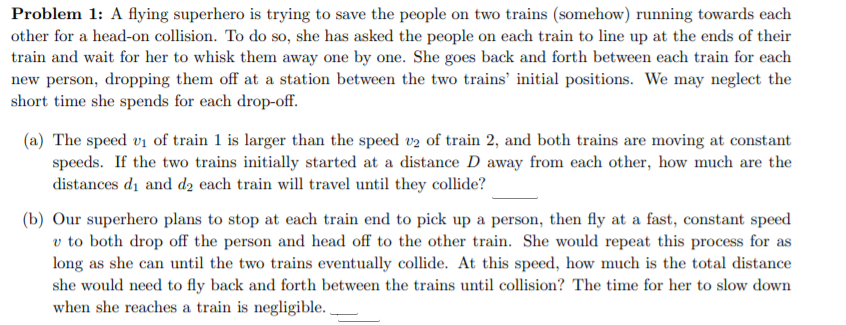Problem 1: A flying superhero is trying to save the people on two trains (somehow) running towards each other for a head-on collision. To do so, she has asked the people on each train to line up at the ends of their train and wait for her to whisk them away one by one. She goes back and forth between each train for each new person, dropping them off at a station between the two trains' initial positions. We may neglect the short time she spends for each drop-off. (a) The speed vị of train 1 is larger than the speed v2 of train 2, and both trains are moving at constant speeds. If the two trains initially started at a distance D away from each other, how much are the distances di and d2 each train will travel until they collide? (b) Our superhero plans to stop at each train end to pick up a person, then fly at a fast, constant speed v to both drop off the person and head off to the other train. She would repeat this process for as long as she can until the two trains eventually collide. At this speed, how much is the total distance she would need to fly back and forth between the trains until collision? The time for her to slow down when she reaches a train is negligible.
Problem 1: A flying superhero is trying to save the people on two trains (somehow) running towards each other for a head-on collision. To do so, she has asked the people on each train to line up at the ends of their train and wait for her to whisk them away one by one. She goes back and forth between each train for each new person, dropping them off at a station between the two trains' initial positions. We may neglect the short time she spends for each drop-off. (a) The speed vị of train 1 is larger than the speed v2 of train 2, and both trains are moving at constant speeds. If the two trains initially started at a distance D away from each other, how much are the distances di and d2 each train will travel until they collide? (b) Our superhero plans to stop at each train end to pick up a person, then fly at a fast, constant speed v to both drop off the person and head off to the other train. She would repeat this process for as long as she can until the two trains eventually collide. At this speed, how much is the total distance she would need to fly back and forth between the trains until collision? The time for her to slow down when she reaches a train is negligible.
Related questions
Question
100%
I need help with part A and B,
Thank you

Transcribed Image Text:Problem 1: A flying superhero is trying to save the people on two trains (somehow) running towards each
other for a head-on collision. To do so, she has asked the people on each train to line up at the ends of their
train and wait for her to whisk them away one by one. She goes back and forth between each train for each
new person, dropping them off at a station between the two trains' initial positions. We may neglect the
short time she spends for each drop-off.
(a) The speed vi of train 1 is larger than the speed v2 of train 2, and both trains are moving at constant
speeds. If the two trains initially started at a distance D away from each other, how much are the
distances di and d2 each train will travel until they collide?
(b) Our superhero plans to stop at each train end to pick up a person, then fly at a fast, constant speed
v to both drop off the person and head off to the other train. She would repeat this process for as
long as she can until the two trains eventually collide. At this speed, how much is the total distance
she would need to fly back and forth between the trains until collision? The time for her to slow down
when she reaches a train is negligible. .
Expert Solution
This question has been solved!
Explore an expertly crafted, step-by-step solution for a thorough understanding of key concepts.
This is a popular solution!
Trending now
This is a popular solution!
Step by step
Solved in 3 steps with 6 images
